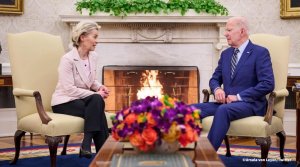US and Europe wrangle over green subsidies to avoid a trade war
As European Commission President Ursula von der Leyen sat in the Oval Office last month she gushed before the cameras about the US Inflation Reduction Act. “It’s great that there’s such a massive investment in wind and clean technologies now,” she said of America’s green awakening.
It wasn’t until the press shuffled out that von der Leyen shifted to a much sterner message, according to people familiar with the meeting. Europe’s executive chief warned President Joe Biden that the law’s bias against European companies was unacceptable, and anything short of a pragmatic fix would become a major irritant in the transatlantic relationship.
The US and EU are negotiating a limited critical minerals deal that may put a salve on those simmering tensions but Washington’s protectionist agenda is still causing anxiety in Brussels, where the US needs help pressuring China. Meanwhile, the Biden administration remains frustrated with what it views as the EU’s rigid adherence to a rules-based trading system that’s no longer fit for purpose.
“Europe was genuinely surprised that the Biden administration didn’t revert back to the pre-Trump days,” said Kelly Ann Shaw, a partner at law firm Hogan Lovells who served on the Trump administration’s trade and economic team. “They missed the memo that the politics on trade have changed.”
If the US and EU can bridge their gaps on trade, they may preserve the west’s economic bulwark against China’s rise and Russia’s expansionism. But if talks flounder, a new transatlantic trade war could undercut a mainstay of the world economic order and create lasting headwinds for global growth.
BUILDING BRIDGES
Since entering office, Biden has made a considerable attempt to repair a transatlantic relationship that frayed during his predecessor’s costly trade wars.
Biden and von der Leyen forged an important 2021 ceasefire in a long-running dispute over illegal subsidies given to Airbus SE and Boeing Co., and both sides shelved duties on about $11.5-billion of each other’s exports.
The peace agreement established a baseline level of trust between US Trade Representative Katherine Tai and her European counterpart, EU Trade Commissioner Valdis Dombrovskis.
The truce also provided a critical foundation to confront back-to-back shocks that highlighted a dangerous over-reliance on authoritarian nations—China’s draconian Covid controls that temporarily shut off much of its economy from the world, followed by Russia’s invasion of Ukraine.
WAR IN EUROPE
Vladimir Putin’s war forced Europe to quickly reorient its energy policy to reduce Russia’s economic leverage, and Beijing’s Covid rules encouraged America to diversify its supply chains outside of China.
Early on, there was common purpose: The EU and US cooperated to impose stiff economic penalties aimed at crippling Putin’s war machine and developed a new energy alliance that turned Europe into the top buyer of US liquefied natural gas.
While leaders on both sides of the Atlantic welcomed this new era of bonhomie after years of tariff skirmishes, their unified front against Russia masked some profound differences over each other’s approaches to trade.
Beyond the more pleasant tone, the Biden administration remains fixated on China and shows far less interest in discussing ways to enhance transatlantic trade cooperation, according to an EU official who declined to be identified due to the private nature of the discussions.
GREEN SUBSIDY PUSH
Over the past year, political leaders in both Brussels and Washington have embraced generous state aid grants and tax credits to help slow the pace of climate change.
These green industrial policies are billed as a rare win-win-win scenario that can simultaneously promote manufacturing jobs in key electoral districts, counterbalance China and reduce carbon emissions.
The proliferation of western environmental subsidies is driving a broader shift in the global market for green goods, and governments are expected to increase their collective clean energy investments by 61% to $2.1-trillion by 2030, according to the International Energy Agency.
The urgency comes after China displaced Europe, Japan and the US as the top manufacturer of key climate-change technologies and inputs like solar panels, wind turbines and rare earth minerals.
The IRA aims to challenge China’s dominance in green technologies and revolutionize America’s clean energy marketplace by providing $369 billion in tax credits and other incentives—though the final figure could end up being far greater.
The European Commission responded to the US subsidy program with its own Net Zero Industry Act, which eases access to EU state aid for clean technology investments.
“The Europeans realized that the size of the benefits the US was offering was so large, it would become a huge incentive for European companies to come here and that would undercut Europe’s manufacturing base,” said Bill Reinsch, who served as a top Commerce official in the Clinton administration. “The way this is evolving, we are both doing the same thing.”
A DIFFERENT TONE
The US law irked many in Brussels where EU officials worried the massive American subsidies would unfairly distort the market for green goods, lead to an exodus of European clean energy investment, and encourage a global subsidy race.
Europe was also concerned that the law’s critical minerals rules would create an unhealthy competition between the US and EU for scarce goods located outside of China, which would paradoxically force European companies to become more reliant on Chinese inputs than ever before.
The EU briefly considered filing a World Trade Organization dispute over the US law’s discriminatory provisions but ultimately decided that a public display of disunity would undermine the broader cause of cooperation against Russia.
“The overall reason that the EU and US are trying to have a civilized disagreement is the war in Ukraine,” said former EU Trade Commissioner Cecilia Malmstrom. “Any obvious cleavage or big disagreement will be used by Putin and that is not a good idea.”
LET’S MAKE A DEAL
The proposed critical minerals deal aims to alleviate these concerns by setting new transatlantic terms aimed at reducing dependence on China for raw materials. In return, the US will provide EU companies with greater access to some of the Inflation Reduction Act’s subsidies and tax credits.
Ultimately, the US wants to create a club of like-minded countries that agree to reduce their dependence on China for raw materials like lithium, cobalt, nickel and magnesium, which are key ingredients for electric motors and batteries. The US and Japan signed a similar agreement in March.
Reducing Europe’s over-reliance on China for key raw materials is a clear priority for Brussels because the EU currently sources some 98% of its rare earth supplies from China. “If we want to be independent, we urgently have to strengthen and diversify our supply chains with like-minded partners,” von der Leyen told European lawmakers in March.
CHINA’S CHARM OFFENSIVE
The critical minerals deal may be a positive step, but the US Treasury Department’s green subsidy guidelines won’t address all of the EU’s concerns.
There also remains a lingering fear in Europe that if Donald Trump is reelected he’ll pivot back to a more combative approach. That’s a point of tension that China is keen to exploit as it works to drive a deeper wedge between the US and Europe.
Over the past decade, and particularly during the Trump administration, China made significant inroads into the European marketplace and strengthened its relationships with Germany, France and the Netherlands.
Last year, Chinese President Xi Jinping hosted German Chancellor Olaf Scholz and a powerhouse delegation of German executives from BASF, Deutsche Bank and BioNTech to underscore Beijing’s close ties with Europe’s largest economy.
Also due to visit Beijing this year are several European heads of state—including Spain’s Pedro Sanchez and France’s Emmanuel Macron, who will travel with Von der Leyen. The EU’s foreign policy chief, Josep Borrell, is also hoping to travel to China soon.
Xi knows that China’s $6.8-trillion consumer marketplace is a critical destination for European exports of cars, pharmaceuticals and machinery. German automakers Volkswagen, Mercedes-Benz and Bayerische Motoren Werke have built dozens of factories in China and all three manufacturers now sell more vehicles in China than any other market.
These companies are acutely aware that there’s a big risk they could someday be at the mercy of sudden changes in China’s rules and standards.
ECONOMIC COERCION
Europe has no plans to completely cut off trade relations with China, but it recognizes the need to minimize its dependencies and strike a more assertive tone, particularly following Beijing’s efforts to penalize Lithuania for its outreach to Taiwan.
In 2021, Lithuania opened a de facto Taiwan mission in Vilnius, which provoked a backlash from Beijing. China downgraded diplomatic ties and restricted Lithuanian trade, which resulted in a 75% drop in Lithuanian exports to China.
But China’s strategy largely backfired as Lithuania and other victims of Beijing’s economic tactics appealed to the EU and US for help. Last week, von der Leyen outlined a new instrument to control European investments abroad in critical sectors.
“We need to ensure that our companies’ capital, expertise, and knowledge are not used to enhance the military and intelligence capabilities of those who are also systemic rivals,” she said.
GLOBAL STEEL AGREEMENT
The US is also hoping to garner EU support for new trade tools to penalize Beijing’s non-market economy practices—like its massive state subsidies for the steel and aluminum sector.
That’s why the US and the EU are negotiating a potential agreement to “drive decarbonization while also limiting anti-competitive and non-market practices” from countries like China, USTR’s Tai told US lawmakers in March.
In December, Tai proposed the creation of a club of nations that would agree to raise tariffs on imports of foreign steel and aluminum produced by carbon intensive practices—a move that’s ostensibly aimed at China.
The US and EU hope to conclude the Global Arrangement on Sustainable Steel and Aluminum before the expiration of a bilateral tariff truce in October. Otherwise, it could trigger a trade war relapse and automatically restore Trump-era tariffs on more than $10 billion of transatlantic exports—like Harley Davidson motorcycles and French wine—as soon as January 1.
“If there isn’t more of a move from now to October to a meeting of the minds, I think you’ll see more interest from the executive and congressional level to move forward with unilateral action from the US,” said Todd Tucker, director of industrial policy and trade at the Roosevelt Institute, a New York-based liberal think tank. The US has “absolutely” been frustrated by the lack of concern from allies about China overcapacity, he said.
CBAM EXEMPTION
While the EU supports the overarching idea of increasing transatlantic cooperation on developing green technologies, Brussels has serious reservations about Biden’s steel deal.
EU officials say the US proposal is controversial because it asks Brussels to exclude US steel and aluminum exports from Europe’s carbon border tax system—a massive regulatory initiative that raises costs on imports of goods produced by countries with looser climate-protection rules. The US envisions a bilateral exemption to the carbon levy that supersedes the EU’s framework, and in the future could be open to other nations that join the arrangements.
US officials want the exclusion because they’re concerned the EU’s carbon border tax will unfairly raise costs on exports of American industrial products—including steel, aluminum, cement and fertilizers.
But EU officials say the deal, as proposed, will violate WTO rules and preserve the US’ ability to impose tariffs at a later date, leaving Europe at the whim of future administrations.
The stakes are massive for getting this right. The US-EU trade relationship is arguably the world’s most influential democratic alliance. Bilateral trade between America and Europe accounts for 42% of the global gross domestic product and directly employs nearly 10 million workers at foreign affiliates on both sides of the Atlantic.
If the US and EU can get on the same page, it could persuade other Group of Seven allies to embrace a new economic order that forces China to play by their rules. “A US that’s allied with Europe seeing eye to eye on China is a much more serious proposition for China,” said Wendy Cutler, a vice president at the Washington-based Asia Society.
Comments
Press Office
Announcements
What's On
Subscribe to improve your user experience...
Option 1 (equivalent of R125 a month):
Receive a weekly copy of Creamer Media's Engineering News & Mining Weekly magazine
(print copy for those in South Africa and e-magazine for those outside of South Africa)
Receive daily email newsletters
Access to full search results
Access archive of magazine back copies
Access to Projects in Progress
Access to ONE Research Report of your choice in PDF format
Option 2 (equivalent of R375 a month):
All benefits from Option 1
PLUS
Access to Creamer Media's Research Channel Africa for ALL Research Reports, in PDF format, on various industrial and mining sectors
including Electricity; Water; Energy Transition; Hydrogen; Roads, Rail and Ports; Coal; Gold; Platinum; Battery Metals; etc.
Already a subscriber?
Forgotten your password?
Receive weekly copy of Creamer Media's Engineering News & Mining Weekly magazine (print copy for those in South Africa and e-magazine for those outside of South Africa)
➕
Recieve daily email newsletters
➕
Access to full search results
➕
Access archive of magazine back copies
➕
Access to Projects in Progress
➕
Access to ONE Research Report of your choice in PDF format
RESEARCH CHANNEL AFRICA
R4500 (equivalent of R375 a month)
SUBSCRIBEAll benefits from Option 1
➕
Access to Creamer Media's Research Channel Africa for ALL Research Reports on various industrial and mining sectors, in PDF format, including on:
Electricity
➕
Water
➕
Energy Transition
➕
Hydrogen
➕
Roads, Rail and Ports
➕
Coal
➕
Gold
➕
Platinum
➕
Battery Metals
➕
etc.
Receive all benefits from Option 1 or Option 2 delivered to numerous people at your company
➕
Multiple User names and Passwords for simultaneous log-ins
➕
Intranet integration access to all in your organisation





















